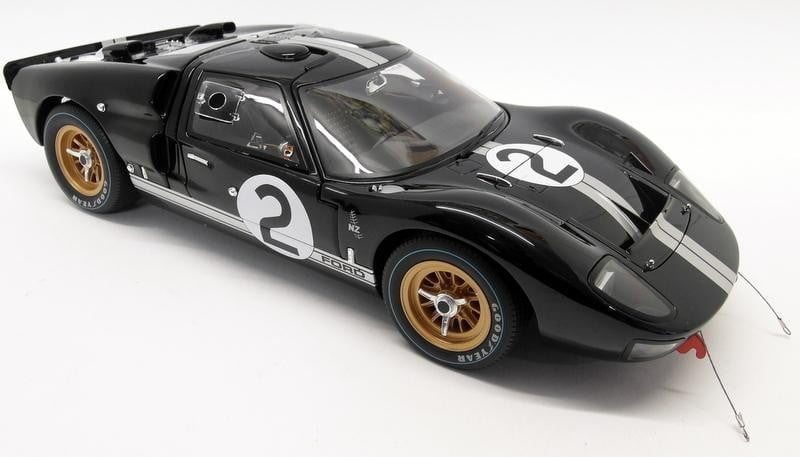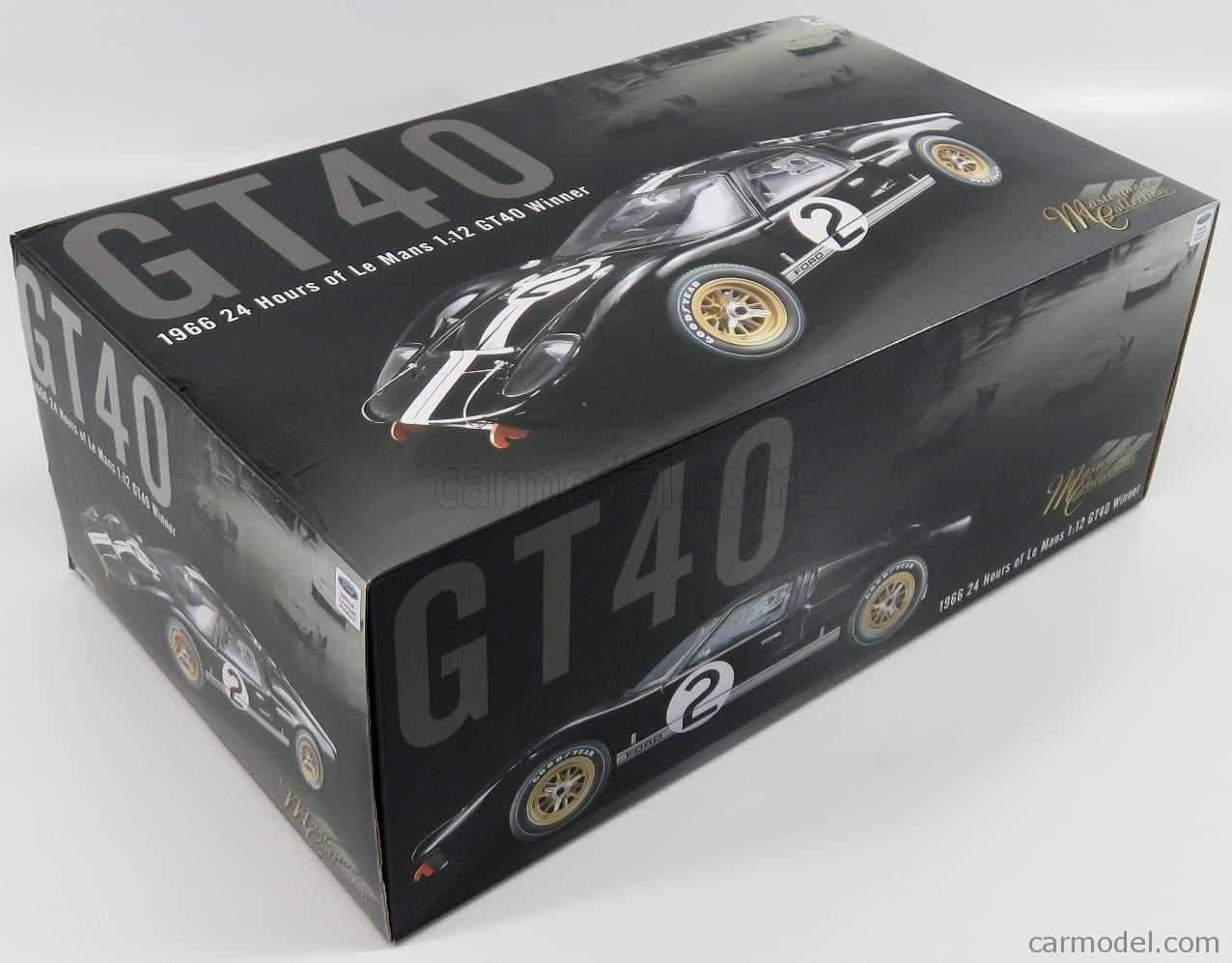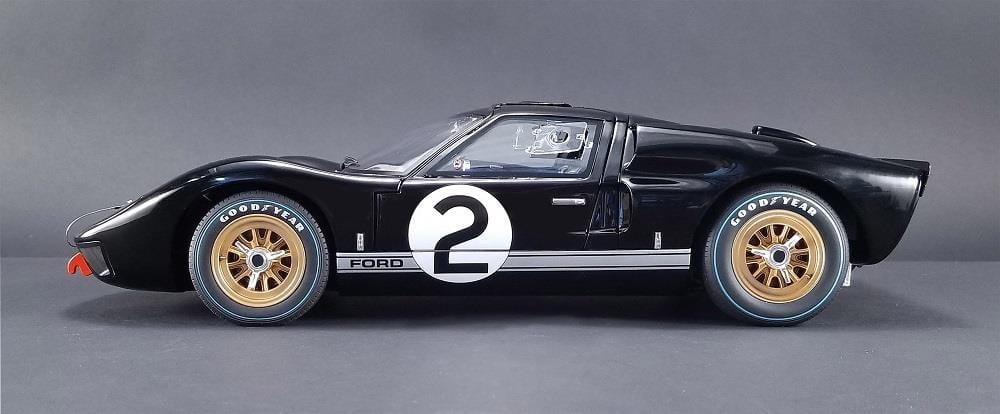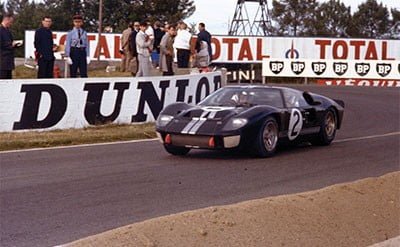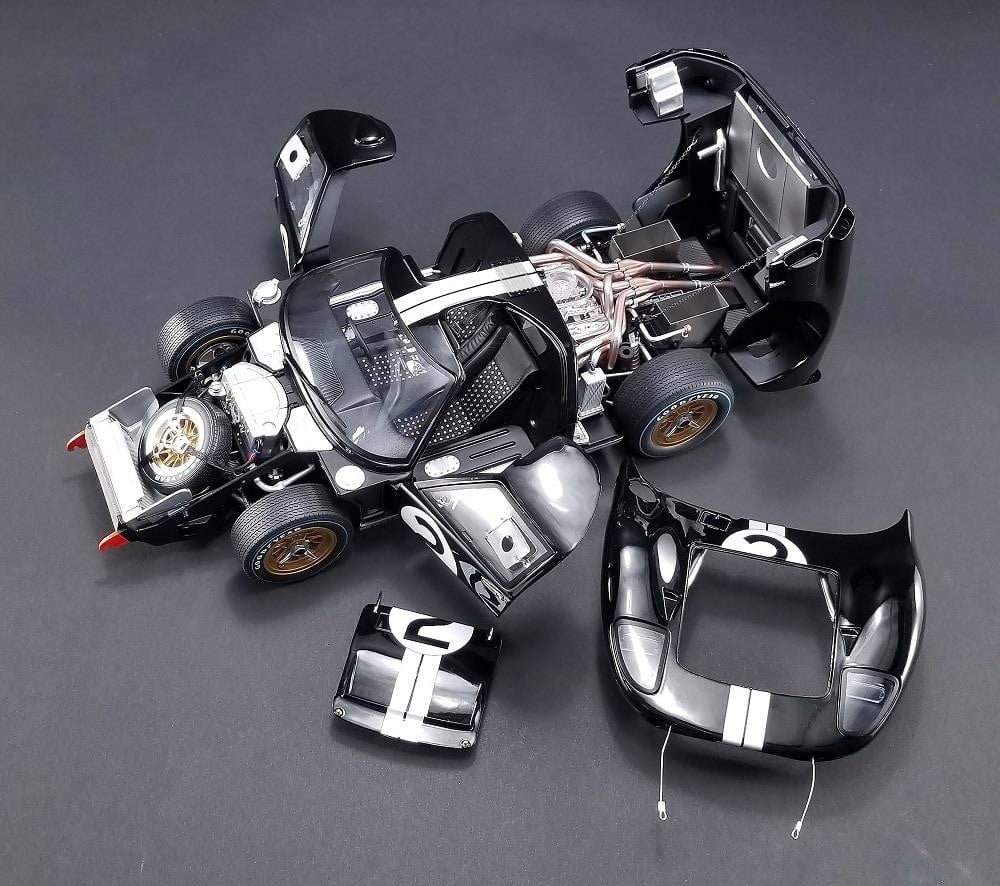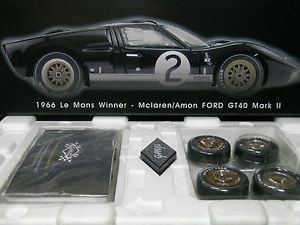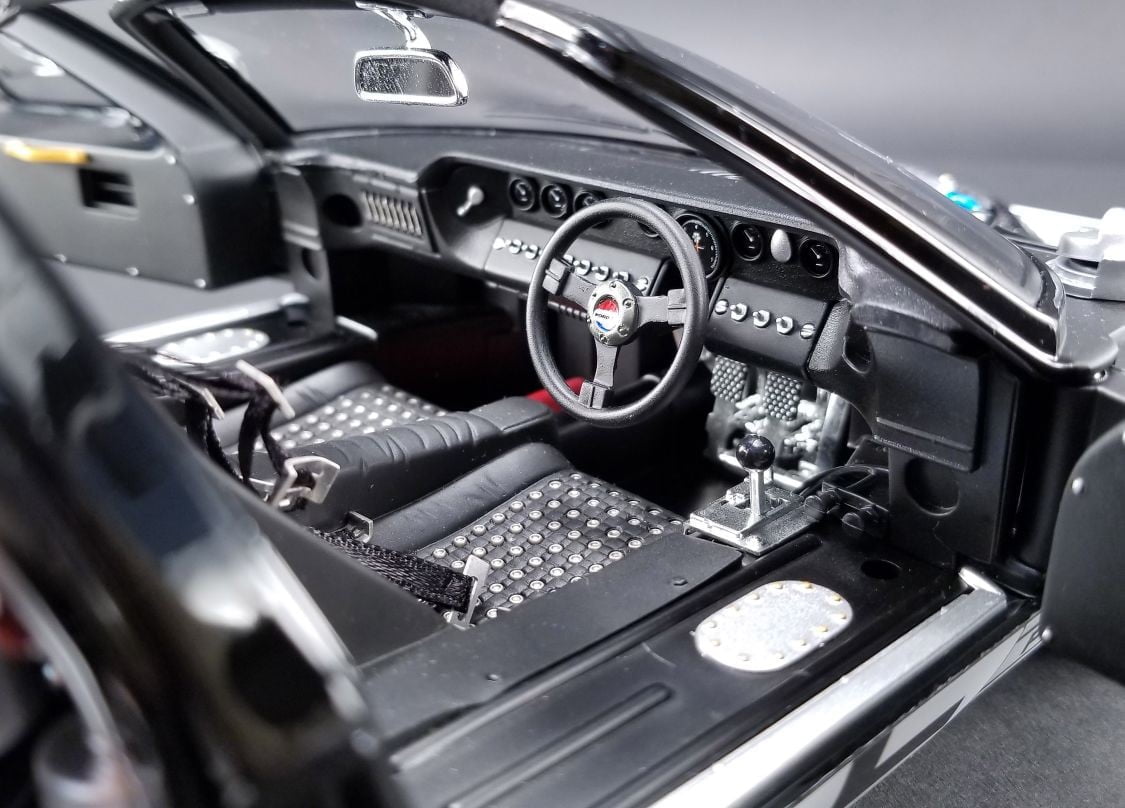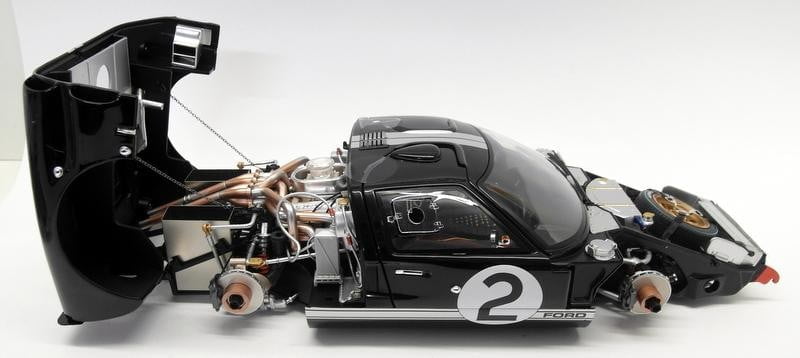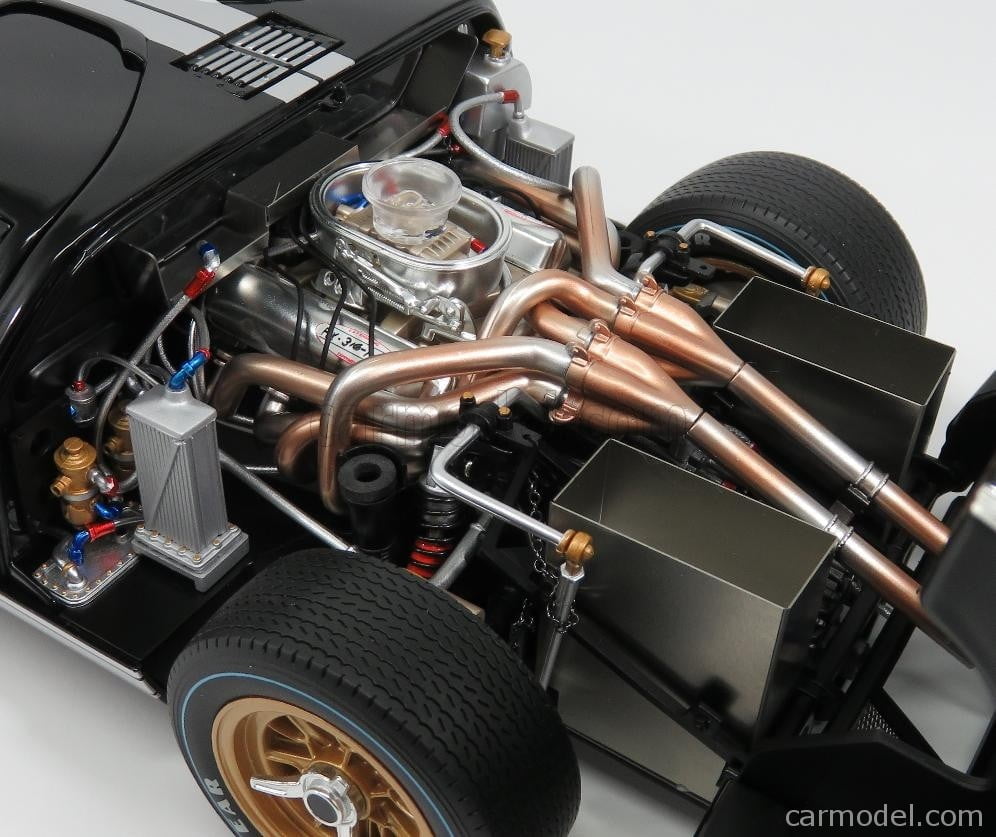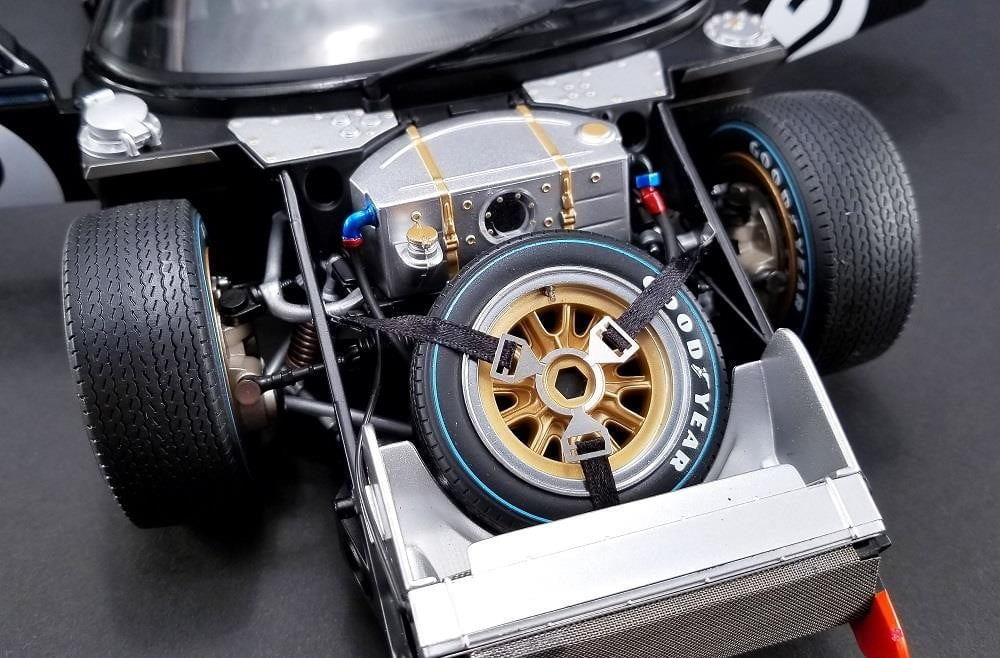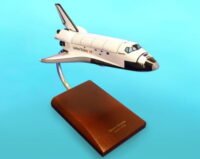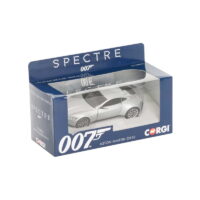NO2- 1966 FORD GT40 MKIIB – 1966 LE MANS WINNER – 50TH ANNIVERSARY EDITION
€700.01
#2 1966 FORD GT40 MKIIB – 1966 LE MANS WINNER – 50TH ANNIVERSARY EDITION 1:12 Scale
1 in stock
- Satisfaction Guaranteed
- No Hassle Refunds
- Secure Payments
Description
Large 1:12 Scale
#2 1966 FORD GT40 MKIIB – 1966 LE MANS WINNER – 50TH ANNIVERSARY EDITION
ACME-MODELS – FORD USA – GT40 MKII TEAM SHELBY-AMERICAN INC. N 2 WINNER 24h LE MANS 1966 B.McLAREN – C.AMON
1:12 Scale
| Part #: | M1201001 |
| Driver: | Bruce McLaren / Chris Amon |
| Color: | Black |
| ModelYear: | 0 |
1966 24 Hours of Le Mans
From Wikipedia, the free encyclopedia
Jump to navigationJump to search
1966 24 Hours of Le Mans
Previous: 1965 Next: 1967
Index: Races | Winners
The 1966 24 Hours of Le Mans was the 34th Grand Prix of Endurance, and took place on 18 and 19 June 1966.[1] It was also the seventh round of the 1966 World Sportscar Championship season. This was the first win at LeMans for the Ford GT40 and the first win for an American car company. It was also the debut Le Mans start for two significant drivers: Henri Pescarolo, who went on to set the record for the most starts at Le Mans; and Jacky Ickx, whose record of six Le Mans victories stood until beaten by Tom Kristensen in 2005.
Le Mans in 1966
Contents
1Regulations
2Entries
3Practice
4Race
4.1Start
4.2Night
4.3Morning
4.4Finish and post-race
5Legacy in Popular Culture
5.1″Go Like Hell”
5.2″The 24 Hour War”
5.3″Ford V Ferrari”
6Official results
6.1Finishers
6.2Did Not Finish
6.3Did Not Start
6.4Class Winners
6.5Index of Thermal Efficiency
6.6Index of Performance
6.7Statistics
6.8Challenge Mondial de Vitesse et Endurance Standings
7References
8External links
Regulations
1966 saw the advent of a completely new set of regulations from the CSI (Commission Sportive Internationale – the FIA’s regulations body) – the FIA Appendix J, redefining the categories of motorsport in a numerical list. GT cars were now Group 3 and Prototypes were now Group 6. Two new classes for Sports Cars were Group 4 and Group 5 for ‘Special Sports Cars’ (Group 1 and 2 covered Touring Cars, Group 7 led to the Can-Am series, with Group 8 and 9 for single-seaters).[2]
As Group 7 were ineligible for FIA events, the Automobile Club de l’Ouest (ACO) opened its entry list to Group 3, 4 and 6. The FIA mandated minimum annual production runs of 500 cars for Group 3 (up from 100 previously[3][4]) and 50 for Group 4,[4] which also had a maximum engine capacity of 5000cc. There were no engine limits on the GTs or Prototypes. As before, the Groups were split up in classes based on engine size, there was a sliding scale of a minimum weight based on the increasing engine size (from 450 to 1000kg for 500 to 7000cc) as was fuel-tank capacity (60 to 160 litres).[2]
Along with the new Appendix J, after four years of focus on GT racing the FIA announced the International Manufacturer’s Championship, for Group 6 Prototypes (2L / >2L), and the International Sports Car Championship for Group 4 (1.3L / 2L / 5L).[2]
Entries
Ford GT40 Mark II
Ferrari 330 P3
Porsche 906 Carrera
With the new regulations this year the ACO received a huge 103 entry requests. Such was the interest in Group 6 there were 43 prototypes on the starting grid and only 3 GT cars
Category Classes Prototype
Group 6 Sports
Group 4 GT
Group 3 Total
Entries
Large-engines 2.5 – 7.0L 21 5 (+3 reserve) 1 (+1 reserve) 27 (+4 reserves)
Medium-engines 1.6 – 2.0L 12 1 (+1 reserve) 2 15 (+1 reserve)
Small-engines 1.0 – 1.3L 13 (+2 reserves) 0 0 13 (+2 reserves)
Total Cars 46 (+2 reserves) 6 (+4 reserves) 3 (+1 reserve) 55 (+7 reserves)
After 2 years of its 3-year program Ford had very little to show for its immense investment. Extensive work was done in the wind-tunnel, and improving the brakes, handling and engine – not least improving the fuel economy.[5][6][7][8] The big 7-litre engine now put out 475 bhp.[4] But the new year started with promise with Ken Miles and Lloyd Ruby winning both the inaugural 24 Hours of Daytona and then Sebring.[6] Copying Ferrari’s tactic of overwhelming numbers, they put in fifteen Mark II entrants; eight were accepted by the ACO. This time six were built and prepared by Shelby American. Shelby ran three cars himself for Americans Dan Gurney and Jerry Grant, Miles was now paired with New Zealander Denny Hulme after Ruby had been injured in a plane-crash a month earlier.[9] The third car was the all-Kiwi pairing of Bruce McLaren and Chris Amon. Holman & Moody, the successful Ford NASCAR race-team was bought on board to race another trio – for Mark Donohue/Paul Hawkins, Ronnie Bucknum/Dick Hutcherson and Lucien Bianchi/Mario Andretti.[10] One of the big improvements Holman & Moody brought with them was a quick-change brakepad system to save time in the pits.[11]
The British team Alan Mann Racing had two cars prepared by Ford Advanced Vehicles, for Graham Hill/Dick Thompson and John Whitmore/Frank Gardner. Each of the eight cars was painted in a colour from the Mustang road-car range.[12][13]
Ferrari’s response to the Mk II was the new Ferrari 330 P3. Shorter and wider than the P2, it kept the same 4-litre engine but fuel-injection now put out 420 bhp.[8] The works team had a pair of closed-cockpit versions for John Surtees/Ludovico Scarfiotti and former winners Lorenzo Bandini/Jean Guichet. An open-cockpit variant was given to the North American Racing Team (NART) for Pedro Rodriguez /Richie Ginther. But their race preparation had been limited by strike action in Italy.[14][6][15]
NART also entered a long-tailed P2, rebodied by Piero Drogo and driven by last year’s winner Masten Gregory with Bob Bondurant. There were also P2/P3 hybrids for the Ecurie Francorchamps (Dumay/”Beurlys”) and Scuderia Filipinetti (Mairesse/Müller. Finally there was a P2 Spyder for Maranello Concessionaires (Attwood/Piper).[14][16] Fighting on two fronts, the company also took on Porsche in the 2-litre class with its Dino 206S with a pair from NART and another for Maranello. Nino Vaccarella, race winner in 1964, was furious when he found out he was ‘demoted’ to drive the Dino rather than the P3 and threatened to walk out, but did, in the end run the car.[17][18]
Chevrolet was the other player in the over 2-litre class. Ex-Ferrari engineer Giotto Bizzarrini had fallen out with Renzo Rivolta and with his own company brought his new design, the P538, but still using the 5.3L Chevrolet engine. The other Chev was in Texan Jim Hall’s Chaparral 2D. The 5.3L ‘small-block’ put out 420 bhp and had an semi-automatic transmission.[15][4] Driven by Phil Hill and Jo Bonnier, they made a big impact winning the Nürburgring round just two weeks earlier.[19]
Porsche came with a new model – the 906 designed by the team led by Ferdinand Piëch. With the 2.0L flat-6 engine from the 911, it had recently been homologated for Group 4 with the requisite 50 cars.[20] It was race-proven too, after winning the Targa Florio the month before. However three langheck (long-tail) prototypes were also entered by the works team, driven by Hans Herrmann/Herbert Linge, Jo Siffert/Colin Davis and Udo Schütz/Peter de Klerk.[21]
Alfa Romeo, and its works team Autodelta, had withdrawn from racing for a year to prepare a new car for 1967. [5] But this year, a significant new manufacturer entered the fray: Matra had bought out Automobiles René Bonnet in 1964, rebadging the Djet. However it was a new design that was entered. The M620 had a 2-litre version of the BRM Formula 1 engine developing 245 bhp that could match the Porsches in speed, making 275 kp/h (170 mph). The three cars were driven by up and coming young French single-seater drivers Jean-Pierre Beltoise/Johnny Servoz-Gavin, Jean-Pierre Jaussaud/Henri Pescarolo and Jo Schlesser with Welshman Alan Rees.[22]
Remarkably, given British dominance of the race barely a decade earlier, there were only three British cars in this year’s race. Defending class-champions Austin-Healey had two works entries. The other was a Marcos Engineering kit-car based on a Mini-Cooper chassis. Entered by Frenchman Jean-Louis Marnat, he was able to get a works engine and gearbox from BMC. The spectators laughed at the small car and its apparent resemblance to a flea.[23] Alpine, after its poor showing in the previous year, returned with 6 cars. The new A210 had a 1.3L Gordini-Renault engine with a Porsche gearbox making it more durable if only a little faster at 245 kp/h (150 mph). This year a new customer team, the Ecurie Savin-Calberson was supported by Alpine, with former Index winner Roger Delageneste.[24]
Charles Deutsch brought his new aerodynamic SP66. The car was powered by a 1130cc Peugeot engine, marking the return of the French company last seen in the 1938 race.[25] Another competitor in the small prototypes was ASA. Originally a Ferrari design by Carlo Chiti and Giotto Bizzarrini before their famous walk-out from Ferrari, it was sold to the new Italian company and uprated with a 1290cc engine giving 125 bhp. Two cars were entered, one by ASA and one by NART.[26]
The new Group 4 category started attracting interest as the earlier prototypes were meeting the homologation and production requirements. There were six GT40s entered by customer teams, with the 4.7L engine. Jochen Rindt, the previous year’s winner, had moved across from Ferrari to Ford, in the new Canadian Comstock Racing Team. They joined Ford France, Scuderia Filipinetti and new privateers Scuderia Bear and Essex Wire. Joining Skip Scott, team owner of the Essex Wire team, among his drivers was a 21-year old Jacky Ickx in his Le Mans debut[27][28])
Up against them was Ed Hugus’ modified Ferrari 275GTB and the Equipe Nationale Belge ran its 275 LM. Porsche also ran three regular 906s in the Sports category, two works entries as well as one for their Paris importer ‘Toto’ Veuillet.
With Shelby now fully concentrated on the Ford program, the Cobra GTs were abandoned. There were only three GT entries: The Ferrari customer teams Ecurie Francorchamps and Maranello Concessionaires both entered a 275 GTB. The third was a quiet though significant entry: Jacques Dewes, ever the pioneering privateer, bought the first Porsche 911 to Le Mans. Production of what would become the ubiquitous Le Mans car had started in late 1964 and the new 911 S model had its ‘boxer’ 6-cylinder engine tuned to 160 bhp.[29]
Finally, in a subcompetition of its own, there was the tyre-race between Firestones, Dunlop and Goodyears.<[5]
Practice
Once again there was rain at the April testing weekend. And once again there was tragedy with a fatal accident. American Walt Hansgen’s Ford hit water on the pit straight an aquaplaned. He aimed for the escape road at the end of the straight, not realising it was blocked by a sandbank, which he hit at about 190 kp/h (120 mph). Taken with critical injuries to the American military hospital at Orléans, he died five days later.[12][9][18]
A notable absentee at the test weekend was the Ferrari works team.[5][18] Chris Amon was fastest at the test weekend in the experimental Ford J-car with a 3:34.4 lap.[4] But come race-week it was Gurney who put in the fastest qualifying lap of 3:30.6, a second faster than his stablemates Miles, Gardner and McLaren. Ginther was 5th in the fastest Ferrari with a 3:33.0, with Parkes and Bandini in 7th and 8th respectively. Phil Hill, in the Chaparral, broke up the Ford-Ferrari procession in 10th.[30]
Jo Siffert put the quickest Porsche 22nd on the grid with 3:51.0, with Nino Vaccarella’s Ferrari in 24th (3:53.5) and Jo Schlesser’s Matra just behind it (3:53.5). Over the test weekend, Mauro Bianchi had surprised many in the 1-litre Alpine, going as fast as the 1959 Ferrari Testa Rossas.[24][18] The quickest Alpine in practice was Toivonen/Jansson (4:20.1), well ahead of the best CD (Ogier/Laurent 4:27.5) and the Austin-Healey’s (4:45.1) and ASAs (4:49.8).[30]
There were also two significant dramas in practice. The biggest news was the walkout of Ferrari’s lead driver John Surtees. He and team manager Eugenio Dragoni had decided that he, as the fastest Ferrari driver and driving with Mike Parkes, would act as the hare to bait and break the Fords. He was also still recovering from a big accident the previous year and would hand over to Scarfiotti if he got overly tired. Yet during raceweek, with news that new FIAT chairman Gianni Agnelli would be at the race, Dragoni changed the plan, putting Scarfiotti (Agnelli’s nephew) in first. Surtees was furious and stormed off to Maranello to argue his case with Enzo Ferrari.[18] Not listened to, Surtees, Ferrari’s 1964 F1 World Champion, quit the team.[14][16][17]
The second incident was more serious – Dick Thompson in the Alan Mann Ford Mk II collided with Dick Holqvist who was going far slower in the Scuderia Bear Ford GT40 and pulled right in front of him at Maison Blanche.[16] Holqvist spun off with heavy damage, while Thompson was able to get back to the pits. While repairing the damage, officials told the team that they were disqualified for Thompson leaving the scene of a major accident. Thompson was adamant he had advised pit officials, and in the hearing Ford’s director of racing Leo Beebe threatened to withdraw all Fords. He was supported by Huschke von Hanstein who was prepared to withdraw the Porsche team as well.[18] In the end, the car was reinstated though Thompson was banned. This still posed a problem for Ford as they were lacking spare drivers, with injuries with A.J. Foyt, Jackie Stewart and Lloyd Ruby.[16] In the end Australian Brian Muir, who was in England was flown over to France. He did his two laps, his first ever at Le Mans on raceday morning to qualify.[27][13][17]
Race
Start
On a cool and cloudy afternoon, it was Henry Ford II this year who was the honorary starter.[18] Last minute raindrops caused a flurry of tyre changes and some cars switched from Firestone to Goodyear or Dunlops.[13][17] At the end of the first lap his cars led – Hill ahead of Gurney then Bucknum. Parkes in the Ferrari, followed by Whitmore’s Ford, the Chaparral, then the GT40s of Scott and Rindt.[13] There had been instant excitement when Edgar Berney spun his Bizzarrini on the start-line amongst the crowd of departing cars.[31][32][18] Miles had to pit after the first lap to fix his door after colliding with Whitmore’s Ford at the start.[6][13] Also pitting on the first lap was Paul Hawkins who’s Ford broke a halfshaft going down the Mulsanne Straight lurching him sideways at nearly 350 kp/h.[13] The Holman & Moody crew took 70 minutes to repair it only for Mark Donohue to have the rear boot blow off down the Mulsanne and find the differential had been terminally damaged.[12][13][33]
On the third lap Gurney took the lead, which he held onto the first pit-stops. McLaren was being delayed by his tyres going off, so the team quietly changed from Firestones to Goodyears.[12] After only 9 laps, Rindt’s Ford blew its engine at the end of the Mulsanne straight, so there would be no consecutive win.[27] At the end of the first hour Fords were 1-2-3, with Gurney leading by 24 seconds from Graham Hill and Bucknum. Fourth, 20 seconds further back was the first NART Ferrari, of Rodriguez. Meanwhile Miles had been putting in extremely fast laps, breaking the lap record and getting back up to 5th place. Parkes was 6th ahead of Bonnier in the Chaparral who had already been lapped. Within another hour Miles and Hulme had taken the lead.[34][6]
At 8pm, only the Miles and Gurney Fords, and Rodiguez’s Ferrari were on the lead lap (#64).[35] At dusk it started to drizzle, reducing the power advantage of the big Fords, and allowing the Ferraris to keep in touch. The Fords were further delayed as a number chose to change brake pads early.[34] By then all three Dinos were out with mechanical issues, removing one threat to Porsche.[18] A major accident occurred when Jean-Claude Ogier’s CD got loose on spilt oil at the Mulsanne kink and was hit hard side-on by François Pasquier in the NART ASA. Both cars hit the wall and caught fire, and Ogier was taken to hospital with two broken arms.[26][25][36]
Night
After 6 hours, heavy rain was pouring down. Ginther’s NART Ferrari was leading from Parkes, chased by the Fords of Miles and Gurney on the same lap, McLaren a lap behind then Bandini and Andretti two laps back. But Andretti was soon sidelined with a blown headgasket, as was the Hill/Muir Ford which had broken its front suspension coming out of Arnage corner.[12][37] As the rain eased the Fords of Miles and Gurney retook the lead. Just before midnight Robert Buchet aquaplaned coming over the crest at the Dunlop Bridge and crashed the French Porsche.[21] The Chaparral had been running well initially, getting as high as 5th, until a broken alternator stopped them also just before midnight while running in 8th.[19]
Another heavy downpour at 12.30 contributed to a big accident in the Esses. Guichet had just spun his Ferrari in the rain and got away when Buchet arrived and crashed his Porsche. Then Schlesser’s Matra ran into the CD of Georges Heligouin avoiding the accident. As the damage was being cleared, Scarfiotti crashed his P3 into the Matra and all four cars were wrecked, although only Scarfiotti taken to hospital, with minor bruising.[34][36]
During the night the Ferraris started to suffer from overheating. When the NART P3 retired at 3am from 4th with a broken gearbox, and the Filipinetti car of Mairesse/Müller from 5th an hour later, the Ferrari challenge was spent – there would be no privateer-saviours for the marque this year. At halfway the Ford Mk IIs held the top-4 places (Miles/Hulme, Gurney/Grant, McLaren/Amon, Bucknum/Hutcherson) with GT40s in 5-6-8: Essex, Filipinetti and Ford-France (Revson/Scott, Spoerry/Sutcliffe, Ligier/Grossman). Siffert /Davis were leading a train of Porsches in 7th and the nearest Ferrari was the Bandini/Guichet P3 limping in 12th. Ford told their cars to drop to 4-minute laps, but Gurney and Miles kept racing hard for the lead.[37]
Morning
What could have been a procession was anything but for Ford. At 8am, a pit-stop for the Filipinetti Ford running 5th spilled petrol on a rear tyre. On his out-lap Spoerry lost traction and spun at the Esses wrecking the car. The Ford-France and Essex cars had already retired with engine issues during the night.[27]
At 9am the Gurney/Grant car, which had been dicing for the lead with Miles & Hulme (against strict team orders), retired from 1st when the car blew a headgasket. That left Ford with only three Mk IIs left (albeit running 1-2-3) as all the GT40s had retired as well. Porsches now held the next five places and the two Ferrari GTs were 9th and 10th chased by the Alpines.
Finish and post-race
With the field covered it was now that Leo Beebe, Ford racing director, contrived to stage a dead heat by having his two lead cars cross the line simultaneously.[38] The ACO told him this would not be possible given the staggered starting formation that the #2 car would have covered 20 metres further. But Beebe pushed on with his plan anyway.[34][39]
At the last pit stop, the Mark IIs were still in front. Miles/Hulme were leading, followed by McLaren/Amon holding station on the same lap. The gold Bucknum/Hutcherson car was third, but twelve laps behind. Miles was told to ease off to allow McLaren to catch up with him. Just before 4pm, it started to drizzle again. As it turned out McLaren’s #2 car crossed the finish line just ahead and was declared the winner. It was rumoured that Miles, upset about the team orders, lifted off to allow McLaren to finish a length ahead.[12][39][40][41][42]
At their last pitstop, the 7th-placed Porsche of Peter Gregg and Sten Axelsson was stopped by engine problems. Gregg parked the car waiting for the last lap, but at 3.50pm he could not get it re-started and missed the formation finish. The other Porsches came in 4th to 7th led by Siffert/Davis who also claimed the Index of Performance. The Stommelen/Klass car in 7th was the first, and only, Sports car to finish. Finally, the new 911 GT ran well and finished 14th starting a long record of success.[21]
Four Alpines finished this year, 9-11-12-13, with that of Delageneste/Cheinisse from the Ecurie Savin-Calberson wining the Thermal Efficiency Index.[24] The final finisher was the little Marcos. Formerly the object of laughter it had become a crowd favourite running like clockwork, despite finishing 26 laps behind the rest of the field.[23][4]
So for Ford it was ‘Mission Accomplished’: it had taken three attempts for Ford to win Indianapolis and the NASCAR Championship, and now it added the Le Mans 24 Hours. After Chrysler had first entered in 1925 after 41 years it was the first win for an American car.[28] The official Ford press release, erroneously dated 7/5/1966, claims:
“The McLaren-Amon and the Miles-Hulme cars were running within seconds of each other as the race neared its end, with the Bucknum-Hutcherson car hanging back as insurance. A decision was made in the Ford pits to have the cars finish side by side in what hopefully would be considered a dead heat. All three cars went over the finish in formation, but any chance for a dead heat disappeared when officials discovered a rule that in case of a tie, the car that had started further down the grid had travelled the farther distance. Since McLaren and Amon had started 60 feet behind Miles and Hulme, they were declared the winners. Both New Zealanders who now reside in England, it was the most important victory yet for the two youngsters. McLaren, who builds his own Formula and sports cars, is 28. Amon 22, is the youngest winner in the history of the event. It was a record shattering performance as the winning car covered more miles (3,009.3) at a faster speed (125.38 mph) than any previous entry. It demonstrated that production engines could compete with racing powerplants and that an American-built car could top Europe’s best.”[1]
The Ford team’s decision was a big disappointment for Ken Miles, who was aiming for the ‘Endurance Racing Triple Crown’—winning Daytona-Sebring-Le Mans—as a reward for his investment in the GT40 development. “I’m disappointed, of course, but what are you going to do about it.”[43] Beebe also later admitted he had been annoyed with Miles racing Gurney, disregarding team orders by potentially risking the cars’ endurance.[12] Two months later, Ken Miles was killed at Riverside while testing the next generation Ford GT40 J-Car, which became the MkIV that won Le Mans in 1967.[12][39][44]
In a race of attrition it was fortunate the big teams bought such quantity – only 3 of the 13 Fords finished and only the two GTs finished from the 14 Ferraris entered. By contrast, 5 of the 7 Porsches finished (including their 911 in the GT class) as did four of the six Alpines, showing much better reliability. It was the first time that the 3000 miles/125mph mark had been exceeded.[28]
Legacy in Popular Culture
“Go Like Hell”
The race became the subject of a 2009 book, detailing the race and the famous background rivalry between Enzo Ferrari and Henry Ford II, by A.J. Baime[45][46] titled “Go Like Hell”—the words shouted by Bruce McLaren to Chris Amon as they drove to their famous victory.[47] Chris Amon was interviewed in 2016:
“Bruce drove the first stints. I recall it was damp and we were running on intermediate Firestone tires and at 210-220mph [355kmh] on the Mulsanne Straight, the tires were shedding tread. I took over from Bruce and he spoke to Firestone and they generously said we could switch to the Goodyears the other GT40s were running. Bruce said to me we had to drive the doors off the thing so we did. There was a bit of history to that. We had both driven the first two 7.0-liter cars at Le Mans the previous year: Bruce with Ken Miles and myself with Phil Hill. We were warned to be careful with the gearbox as they were new and unproven, and both cars retired with gearbox failures. As a result, when I went to Daytona for the 24 hours, paired with Bruce, I suggested to Bruce that we set a fairly conservative pace for the race, and whilst we might be running out of the top three in the early stages, we might be the only one there at the end. We finished fifth. For Le Mans, we decided to set a pace for ourselves. This strategy fell apart when our tires started losing treads early in the race and we lost considerable time. When I was called in to change tires, I think Bruce’s frustration had reached boiling point, he put his head through the car door and said ‘Go like hell!’.” At the finish: “the idea was that the leading GT40s would cross the line together, but in practice, it wasn’t possible to have a dead heat. We weren’t sure who had won initially.”[48]
Rumors of a movie adaption of the book, an Amazon best seller,[49] circulated from 2013 to 2015.[50][51] The book attained a “4.5 star” rating by book review website GoodReads.com.[52]
“The 24 Hour War”
A 2016 documentary film, produced and directed by Americans Nate Adams[53] and Adam Carolla,[54] features the Le Mans rivalry between Ferrari and Ford.[55] The production was well received critically, attaining a “100%” rating on review aggregate website Rotten Tomatoes,[56] and a “five-star” rating on electronic commerce company Amazon.com.[57]
“In 1966, Ford won the 24 Hours of Le Mans for the first time. The following year, they won again. The year after that, they won a third time. And in 1969, a fourth.
That achievement was arguably the greatest in the company’s history. It came after years of struggle, more than a few public failures, and enough burnt cash to refloat the Titanic. Ford’s Sixties Le Mans program was famously the result of a dispute between Henry Ford II and Enzo Ferrari—Ford had tried to purchase Ferrari (the company), only to have Enzo shut down the sale at the last minute. Ford the man vowed to get even, aiming his considerable resources at Ferrari’s Le Mans record. The resulting warpath employed everyone from Bruce McLaren to Carroll Shelby and Indy 500 legend A.J. Foyt, putting the stops to Ferrari’s unbroken, five-year winning streak at La Sarthe.
Collectively, Ford’s wins were one of countless bright moments in a golden decade for both motorsport and culture in general. That first win made it onto the front pages of European newspapers, and it actually helped sell new cars. Ferrari never won Le Mans again, but Ford wouldn’t go back until 2016. When Dearborn won last year, the world went less than nuts. But that makes sense: Both Le Mans and international motorsport are different now, tamer and less raw. So is the automobile itself. Racing is no longer a brutally dangerous pastime or the kind of thing that puts whole countries on the edge of their seats. And most of all, in 2016, there is no Henry the Deuce, no world-altering grudge match, no Enzo, no Carroll. The Ford-Ferrari war pivoted on how these men operated and thought, and they made that story what it was.”–Sam Smith, Adam Carolla’s ‘The 24 Hour War’ Is a Car Movie by Car People That Isn’t Just for Car People, Road and Track, Jan. 18, 2017.[58]
“Ford V Ferrari”
Ford V Ferrari is an upcoming movie based on the rivalry between Ford and Ferrari for the dominance at Le Mans endurance race that has been in works at 20th Century Fox. Initially it was going to star Tom Cruise and Brad Pitt but the project fell apart after a script was drafted by writers Jez Butterworth and John-Henry Butterworth.[59] . After the critical and financial success of Logan (2017), its director James Mangold chose to make this movie. The movie goes into production in the summer of 2018 in California.
Official results
Finishers
Results taken from Quentin Spurring’s book, officially licensed by the ACO[60] Class Winners are in Bold text.
Pos Class No Team Drivers Chassis Engine Laps
1 P
+5.0 2 United States Shelby American New Zealand Bruce McLaren
New Zealand Chris Amon Ford GT40 Mk.II Ford 7.0L V8 360
2 P
+5.0 1 United States Shelby American United Kingdom Ken Miles
New Zealand Denny Hulme Ford GT40 Mk.II Ford 7.0L V8 360
3 P
+5.0 5 United States Holman & Moody United States Ronnie Bucknum
United States Dick Hutcherson Ford GT40 Mk.II Ford 7.0L V8 348
4 P
2.0 30 Germany Porsche System
Engineering Switzerland Jo Siffert
United Kingdom Colin Davis Porsche 906/6 LH Porsche 1991cc F6 339
5 P
2.0 31 Germany Porsche System
Engineering Germany Hans Herrmann
Germany Herbert Linge Porsche 906/6 LH Porsche 1991cc F6 338
6 P
2.0 32 Germany Porsche System
Engineering Germany Udo Schütz
South Africa Peter de Klerk Porsche 906/6 LH Porsche 1991cc F6 337
7 S
2.0 58
(reserve) Germany Porsche System
Engineering Germany Günter Klass
Germany Rolf Stommelen Porsche 906/6 Carrera 6 Porsche 1991cc F6 330
8 GT
5.0 29 United Kingdom Maranello Concessionaires United Kingdom Piers Courage
United States Roy Pike Ferrari 275 GTB
Competizione Ferrari 3.3L V12 313
9 P
1.3 62
(reserve) France Société Automobiles
Alpine France Henri Grandsire
Italy Leo Cella Alpine A210 Renault-Gordini 1296cc S4 311
10 GT
5.0 57
(reserve) Belgium Ecurie Francorchamps Belgium Pierre Noblet
Belgium Claude Dubois Ferrari 275 GTB
Competizione Ferrari 3.3L V12 310
Additional information
| Weight | 10 kg |
|---|

